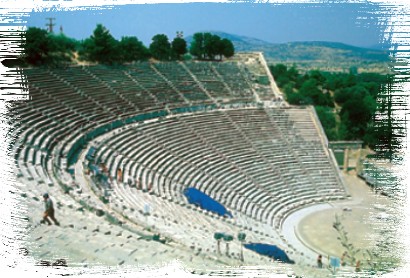

In
an idyllic wooded area in the hinterland of Epidauria, the people of
Epidaurus founded a sanctuary of Asklepios, which grew to become the most
important medical centre of the ancient world. The cult of Asklepios, who
was believed to be responsible for the curing of diseases, spread to this
part of the Peloponnese in the sixth century BC, and the God was honoured
in great splendour. His sanctuary at Epidaurus developed into the most
important centre of healing, and many superb buildings were erected there.
The sanctuary functioned for á thousand years and it was at the peak of
its fame during the Classical and Hellenistic periods.
In
the archaeological site, there are ruins of many magnificent buildings to
see: the Roman Odeon, the stadium and the hippodrome (of the fifth century
BC), the temple of Artemis (300 BC), the striking building called the
Tholos (360-320 BC), the Doric temple of Asklepios with its interesting
sculptures (380-375 BC), the Abaton or Encoemeterion where the sick were
treated (fourth century BC), the temple of Themis (fourth century BC) and
the propylaea (monumental entrance) to the sanctuary. Of course, the most
important monument of á11 is the famous theatre, which is still used for
performances in the summer months. It dates from the late fourth or early
third century BC, and even in antiquity was renowned for its harmonious
proportions and its unique acoustics. The interesting findings from the
sanctuary can be seen in the National Archaeological Museum in Athens and
in the museum inside the archaeological site.